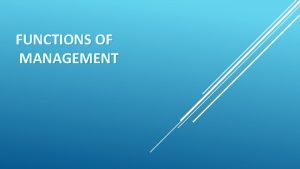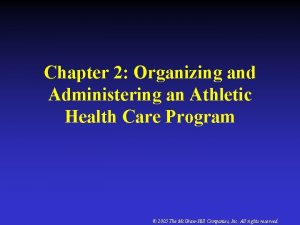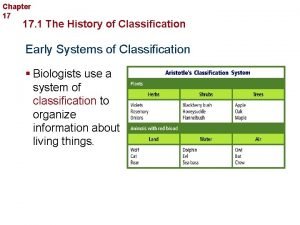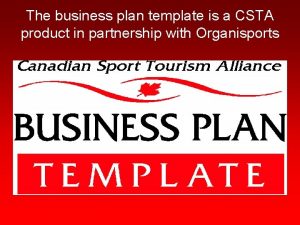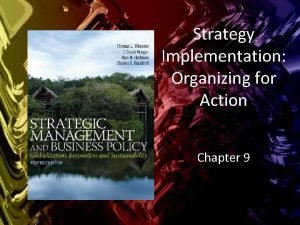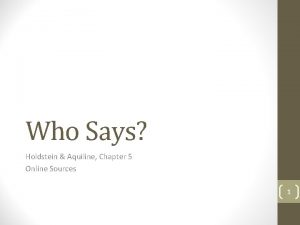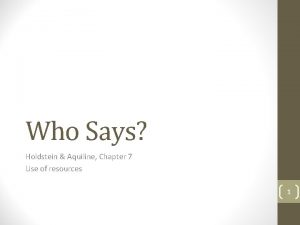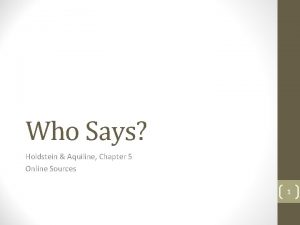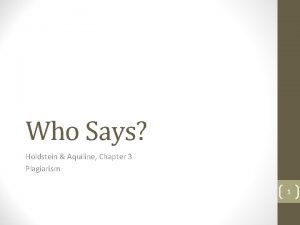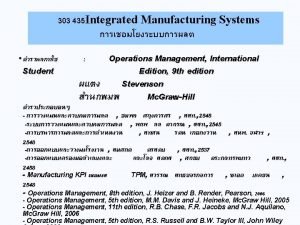Who Says Holdstein Aquiline Chapter 8 Writing organizing








- Slides: 8

Who Says? Holdstein & Aquiline, Chapter 8 Writing, organizing, outlining 1

Crafting your argument • Note that "argument" here is a term for a position or claim, not a dispute. Main parts: 1. Claim = answer to your RQ; often answers the "So what? " question; avoid bias; make it debatable 2. Reasons = claim is supported because … this shows your line of thought; is it logical? 3. Evidence = your research; data is important; credible; relevant This paper holds that (claim) because of (reasons) based on (evidence). 2

Organizing • Collect all your notes, printouts. • Look for gaps in the materials 3

Outlining This is usually a form of pre-writing for your draft, although some start the draft before the outline. The outline should include: • Why you chose this topic • Your research questions and thesis statement [ the “answer” to the main question] • The evidence that will help make your argument (support your thesis) • Brief summary of ideas that come from each source with short citations (e. g. discuss Smith results ) • What have you learned, concluded [and what would you need to know next? ] Format is up to you [see handout, assignment]; formal (I then A, B etc. ) or informal often with questions How serious is X? 4

Bibliography [Technically, a bibliography is an exhaustive list on your topic; you are collecting a list of References or Works Cited] Annotations that you have been doing will help you organize your outline. Usually include summary, relevance [and author/source ethos] No need to include the annotations with your final paper, just the Works Cited list in alphabetical order. 5

Title This matters. They often have two parts with a colon, as in the Snapchat paper Even a “working title” can help you focus your paper 6

Planning and drafting • You might both do an outline and write some of the paper [that’s why you were asked for the intro and conclusion with the outline] • There’s a good list of what you need to begin a full draft on pp. 113 -114. It reflects the process approach we have used during the semester. Note that they suggest • • • Thesis is focused You have supporting arguments backed by evidence You might not have a clear introduction yet You have to start at some point Don’t worry about spelling etc. on the first draft 7

The written structure • • Intro/body/conclusion Consider subheadings for these, and within the body Intro might be last thing you write Structures can be: Chronological Narrative Inductive from specifics to general conclusion [Deductive] General statement, then evidence [most research papers are like this] • Compare and contrast • Cause and effect • Definition [note these last two are not argument papers] • • • Be sure to make good use of transitions 8
 Planning, organizing, staffing, writing.
Planning, organizing, staffing, writing. Chapter 2 worksheet organizing and administering
Chapter 2 worksheet organizing and administering Chapter 17 organizing life's diversity answer key
Chapter 17 organizing life's diversity answer key What does jem do that shocks dill and scout
What does jem do that shocks dill and scout Chapters 4-7 to kill a mockingbird summary
Chapters 4-7 to kill a mockingbird summary Work portfolio examples
Work portfolio examples Staffing and directing
Staffing and directing Organizing committee structure for an event
Organizing committee structure for an event Structure follows strategy
Structure follows strategy
